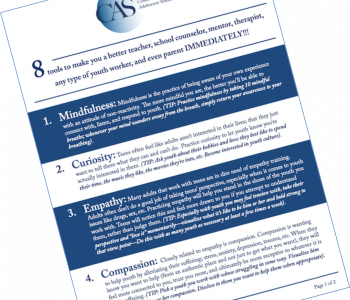

Catharine Hannay, MA
Catharine Hannay is the founder of MindfulTeachers.org and the author of Being You: A Girl’s Guide to Mindfulness, a workbook for teen girls on mindfulness, compassion, and self-acceptance.
How to Talk About Marijuana so Teens Will Listen: 4 Essential Tips
Talking with teens about marijuana can be challenging. The following tips will help you communicate effectively with youth about their reasons for using cannabis and how it could be impacting them.
Tip #1. Reframe the Conversation
Dr. Sam Himelstein, the director of the Center for Adolescent Studies, has some advice for any adult who’s trying to talk with teens about using marijuana and other drugs:
“Youth expect to be lectured and will likely tune out an overly simplistic message: ‘Don’t do drugs. They’re bad. If you do drugs, you’re bad.’ That’s what they expect to hear and it isn’t helpful.
I usually start with something like: ‘I’m not here to tell you what to do and what not to do. That’s not my purpose. I’m here to help you develop self-awareness.’ What I’m trying to do is reframe the conversation. I’m not in opposition to them; I’m trying to help them with their challenges.
Of course I don’t think we should encourage youth to smoke marijuana. But coming down hard on them in an authoritarian way actually makes it less likely they’ll change their behavior. If you can skillfully start a conversation with them, you’re more likely to get the results you want.
They’re much more likely to follow our advice if they believe that we understand them and care about them, rather than just telling them ‘Don’t do drugs.’”
Tip #2: Figure Out What Motivates Them
When behavioral change specialist Shahroo Izadi ran a weekly support group for regular marijuana users, “They were adamant that they were not addicted to cannabis and that it wasn’t currently impacting their lives in a way that was problematic.” (The Kindness Method, p. 128)
After several discussions with the youth, Izadi discovered that there was one issue they were concerned about: how much money they were spending to support their marijuana habit. She decided to use that as a starting point to talk about the long-term impact of their behavior.
“We would discuss how much their tolerance had increased since they first started smoking, and hypothesize about what that meant for the next couple of years—at the very least financially. We would talk about whether they wanted to be drug users into adulthood, and if the answer was no (as it most often was), then at what point they saw themselves changing.
In this way, rather than focus on what was bad about what they were doing now, we discussed what kind of life they’d be excited to have in five years’ time, and the focus, qualifications or finances they would need to get there.” (The Kindness Method, p. 130)
Tip #3: Use a Trauma-Informed Approach
Dr. Sam Himelstein says that “there’s a big reason kids use weed, whether they’re conscious of it or not—part of the job of the adult is to help them understand why they’re using.”
“In my therapy practice, the number one reason is that they’re trying to deal with trauma.
I’ve seen hundreds of clients with substance abuse disorder and trauma, in my private practice, in outpatient chemical dependency treatment, and with youth incarcerated at juvenile hall. This includes boys and girls, from affluent and impoverished backgrounds and of different ethnicities. Basically, they’re all trying to self-medicate.
These youth don’t need a lecture about the dangers of drug use. They need me to empathize with them and validate their experience. Then they need me to teach them other ways of coping with their anger and grief.”
For more detailed information on trauma-informed therapy and substance abuse treatment, see these books by Dr. Sam Himelstein:
And here at the Center for Adolescent Studies, you can:
- take a self-paced course on Mindfulness for Trauma and Addiction; or
- become a certified mindfulness-based substance abuse training (MBSAT) facilitator
4. Provide Accurate Information
Most teens are aware of the dangers of binge drinking or using ‘hard drugs’ like cocaine or heroin, but they may not understand the potential consequences of marijuana use.
Part of the problem is that
“The negative effects may be subtle or may not become apparent for years. And while those who preach that marijuana will kill you, make you crazy, or make you shoot heroin are wrong, usually so are people who claim it’s harmless.”
(David and Nic Schiff, High: Everything You Want to Know About Drugs, Alcohol, and Addiction, p. 101)
Another part of the problem is that, as cannabis becomes more accepted in mainstream society, there’s a lowered perception of risk. As Alex Halpern explains in The Cannabis Dictionary, the legalization of marijuana has led to a vast social experiment. Products containing THC are being sold as part of the multibillion dollar, poorly-regulated ‘wellness industry.’ And many of these products are sugary treats that appeal to kids, like gummy bears and ice cream.
Is it any wonder teens are confused?
Here are some suggested answers to their typical comments and questions.
“My dad/grandpa/Uncle Phil smoked when he was my age, and he turned out fine.”
The level of THC in marijuana has been increasing over the past few decades, so it’s much stronger now than what people were smoking in the ‘60s or the ‘90s.
“It’s just a plant, so how can it be dangerous?”
Cannabis is indeed a plant.
So is tobacco.
And poison ivy.
The fact that something is a plant doesn’t mean it can’t be harmful.
“It’s legal, so what’s the problem?”
Cannabis use isn’t legal everywhere. And where it is legal, that usually just applies to adults over the age of 21.
As with alcohol, the age limit on cannabis isn’t there to prevent teens from having a good time. The younger you start using, the greater the risk of addiction, and it can also have an impact on the way your brain develops.
“It’s a medicine, so it must be good for me.”
It’s true that doctors sometimes prescribe cannabis for specific types of patients. As with any prescription drug, it can cause problems if you use too much or if you don’t have a particular medical condition.
Also, as Alex Halperin points out, “The cannabis industry wants consumers to believe that marijuana is part of a healthy, active life.” (The Cannabis Dictionary, p. 215) Most of the companies are just trying to attract more customers so they can make more money. They’re not doing medical research on what happens when people eat candy full of THC every day.
“Come on, what’s the worst that can happen?”
It’s true that not everyone who tries marijuana will become an addict or have their life fall apart. But there are real consequences, especially if you start when you’re very young and/or if you continue to use cannabis for several years. (And it can be quite dangerous for anyone with a family history of schizophrenia.)
The risks of cannabis use include:
- Impaired Driving
“Research shows that drivers on marijuana have slower reaction times, impaired judgement, and problems responding to signals and sounds.” This leads to an increase in fatal car accidents. (Drug Information for Teens, p. 155-156)
- Alterations in Brain Structure
“The faulty memory and slow reaction times of teens when they’re high may become permanent problems in adulthood.” (High: Everything You Want to Know About Drugs, Alcohol, and Addiction, p. 104)
- Respiratory Problems
Smoking marijuana can lead to “a persistent cough, an increased risk of colds, flu, and lung infections, and an increased risk of cancer of the respiratory tract and lungs.” (How to Raise a Drug-Free Kid, p. 248)
- Increased Risk of Using Other Drugs
“While most marijuana users do not go on to use other drugs, long-term studies of high school students show that few young people use other illegal drugs without first trying marijuana. For example, the risk of using cocaine is much greater for those who have tried marijuana than for those who have never tried it.” (Drug Information for Teens, p. 158)
Conclusion
In order to talk effectively with teens about marijuana, it’s important to:
1) establish yourself as a safe (but not permissive) adult who has their best interests at heart;
2) provide honest and accurate information about marijuana and how it can affect teens; and
3) help them develop self-awareness about:
- their reasons for using cannabis;
- how their drug use is impacting (or is likely to impact) them personally; and
- the types of choices they can make in order to thrive long-term.
Related Posts
- “Did you ever do drugs?” Skillful Self-Disclosure for Adults working with Adolescents
- The Five Major Types of Drugs Used by Teens
- Substance Abuse Treatment Does NOT Happen In A Vacuum
- 3 Tips for Using Mindfulness in Substance Abuse Treatment with Adolescents
- Three Ways Traumatic Events in the Lives of Teens Impact Substance Abuse

